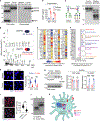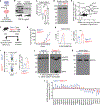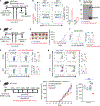Hyperglycosylation of prosaposin in tumor dendritic cells drives immune escape
- PMID: 38207022
- PMCID: PMC11398950
- DOI: 10.1126/science.adg1955
Hyperglycosylation of prosaposin in tumor dendritic cells drives immune escape
Abstract
Tumors develop strategies to evade immunity by suppressing antigen presentation. In this work, we show that prosaposin (pSAP) drives CD8 T cell-mediated tumor immunity and that its hyperglycosylation in tumor dendritic cells (DCs) leads to cancer immune escape. We found that lysosomal pSAP and its single-saposin cognates mediated disintegration of tumor cell-derived apoptotic bodies to facilitate presentation of membrane-associated antigen and T cell activation. In the tumor microenvironment, transforming growth factor-β (TGF-β) induced hyperglycosylation of pSAP and its subsequent secretion, which ultimately caused depletion of lysosomal saposins. pSAP hyperglycosylation was also observed in tumor-associated DCs from melanoma patients, and reconstitution with pSAP rescued activation of tumor-infiltrating T cells. Targeting DCs with recombinant pSAP triggered tumor protection and enhanced immune checkpoint therapy. Our studies demonstrate a critical function of pSAP in tumor immunity and may support its role in immunotherapy.
Conflict of interest statement
Figures





Update of
-
Hyperglycosylation of prosaposin in tumor DCs promotes immune escape in cancer.bioRxiv [Preprint]. 2023 Jun 14:2023.06.14.545005. doi: 10.1101/2023.06.14.545005. bioRxiv. 2023. Update in: Science. 2024 Jan 12;383(6679):190-200. doi: 10.1126/science.adg1955. PMID: 37398287 Free PMC article. Updated. Preprint.
References
-
- Vesely MD, Kershaw MH, Schreiber RD, Smyth MJ, Annu. Rev. Immunol 29, 235–271 (2011). - PubMed
MeSH terms
Substances
Grants and funding
LinkOut - more resources
Full Text Sources
Medical
Molecular Biology Databases
Research Materials
Miscellaneous

